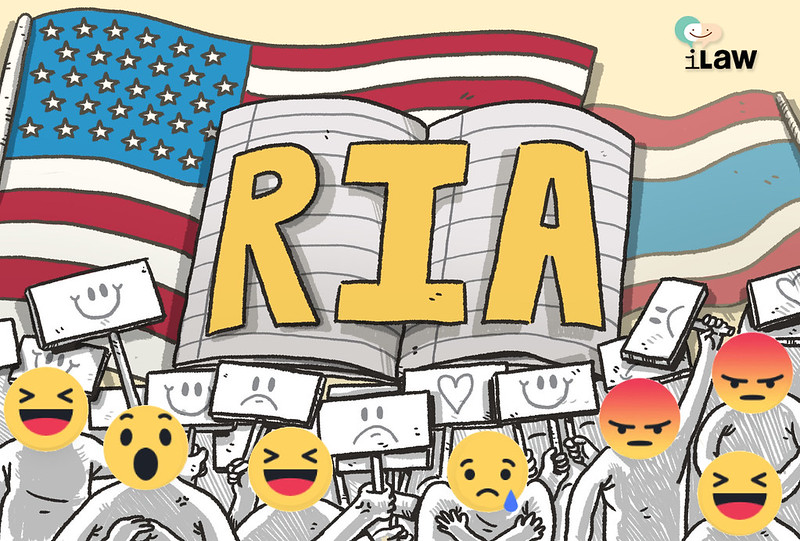วันเสาร์ที่ 8 พฤศจิกายน พ.ศ. 2568
ข่าวด่วน
- ตั้งสติให้ดี “โลกนี้ มีเกิด มีตาย”Posted 8 months ago
- อย่าหาเรื่องอยู่ร้อน นอนทุกข์Posted 8 months ago
- โลกธรรมPosted 9 months ago
- อนุโมทนา คนพิการสู้ชีวิตPosted 9 months ago
- สลายความเกลียดชังPosted 9 months ago
- สู้ดีกว่าลาโลกPosted 9 months ago
- ใช้คาถาพระพยอมบ้างPosted 9 months ago
- เสียงชื่นชมดีกว่าเขาด่าPosted 9 months ago
- ต้องใช้ยาแรงกับคนขายชาติPosted 9 months ago
- บทเรียนผู้เห็นกงจักรเป็นดอกบัวPosted 9 months ago
ความรู้เบื้องต้นการทำ RIA แบบอเมริกา
On July 13, 2017

เว็บไซต์ iLaw ได้รายงานว่าตามที่ รัฐธรรมนูญมาตรา 77 กำหนดให้รัฐต้องจัดทำ กระบวนการ RIA หรือการประเมินผลกระทบจากการออกกฎหมาย แต่เรื่องนี้ยังใหม่มากสำหรับไทย มติคณะรัฐมนตรีที่ออกตามมาจังยังดูไปในทางตรงข้ามกับ RIA ที่ฝันจะเห็นกัน ลองดูตัวอย่างของอเมริกาที่มีประสบการณ์มาก่อนเป็นสิบปี กฎหมายบ้านเขาเขียนขั้นตอนการเปิดรับฟังความเห็นประชาชนไว้น่าสนใจ
การประเมินผลกระทบของการออกกฎหมาย หรือ Regulatory Impact Analysis (RIA) เป็นกระบวนการประเมินผลที่อาจจะเกิดขึ้นก่อนที่รัฐจะออกนโยบายหรือกฎระเบียบใดๆ
องค์กรเพื่อความร่วมมือในการพัฒนาเศรษฐกิจ หรือ Organisation for Economic Cooperation Development (OECD) อธิบายว่า RIA ใช้วัดประโยชน์ที่อาจจะได้รับ ค่าใช้จ่าย และผลกระทบที่อาจเกิดขึ้นต่อสังคม เพื่อสร้างความมั่นใจว่า นโยบายของรัฐได้ถูกตรวจสอบอย่างถี่ถ้วน และรัฐบาลได้ตัดสินใจเลือกทางที่ดีที่สุดจากทางเลือกทั้งหมดที่มีอยู่
ยิ่งในยุคสมัยที่เศรษฐกิจยุคใหม่เติบโตเพิ่มความซับซ้อนขึ้นอย่างรวดเร็ว การออกกฎหมายของรัฐบาล ส่งผลโดยตรงต่อทุกภาคส่วน และกลุ่มผลประโยชน์ต่าง ๆ การทำ RIA จะประสบความสำเร็จหรือไม่ ปัจจัยชี้วัดที่สำคัญ คือ การมีส่วนร่วมของประชาชนในทุกขั้นตอน โดยเฉพาะการเปิดรับฟังความคิดเห็นของประชาชน
ทำไมการรับฟังความคิดเห็นจากประชาชนจึงสำคัญต่อกระบวนการ RIA?
เพราะโดยส่วนใหญ่แล้วการออกกฎหมายใดๆ ของรัฐบาลจะกระทบต่อคนจำนวนมาก และเรารู้ว่า ไม่ใช่ทุกกรณีที่รัฐบาลจะรู้ปัญหากับทางแก้ไขอย่างดีที่สุดเสมอไป กฎหมายจึงควรถูกเขียนขึ้นภายใต้บรรยากาศที่เปิดกว้างและโปร่งใส ข้อมูลและรายละเอียดต่างๆ ที่เกี่ยวข้องกับการร่างกฎหมาย ควรต้องเปิดเผยต่อสาธารณะ เพื่อให้ประชาชน พรรคการเมือง กลุ่มสหภาพแรงงาน ภาคธุรกิจ เอ็นจีโอ รวมทั้งผู้ที่เกี่ยวข้องทุกส่วน สามารถเสนอความคิดเห็นที่เป็นประโยชน์ต่อกระบวนการร่างกฎหมายได้ คนบางกลุ่มอาจจะสามารถนำเสนอความรู้เฉพาะทาง ความเชี่ยวชาญในบางเรื่อง หรือมุมมองและความคิดเห็นใหม่ๆ ต่อนโยบายและการออกกฎหมายที่ส่งผลต่อพวกเขาหรือกลุ่มของพวกเขาได้
การได้พูดคุยในบรรยากาศที่เหมาะสม จะเปิดโอกาสให้รัฐบาลได้มองเห็นผลกระทบจากนโยบายหรือกฎหมาย ที่รัฐบาลอาจไม่ได้ตั้งใจให้เกิดขึ้น รวมทั้งมองเห็นปัญหาในทางปฏิบัติหากมีการบังคับใช้กฎหมายนั้น ทำให้กระบวนการออกกฎหมายมีคุณภาพมากขึ้น
ดังนั้น วิธีการที่ดีที่สุดที่จะประเมินผลกระทบจากการออกกฎหมายของรัฐบาล ก็คือการให้ประชาชนเข้ามามีส่วนร่วมในทุกขั้นตอน ให้ประชาชนรู้สึกเป็นเจ้าของร่วมกันในกระบวนการออกกฎหมาย เมื่อออกกฎหมายมาแล้วจึงจะทำให้ประชาชนยินยอมที่จะปฏิบัติตาม
อะไรเป็นหลักการสำคัญที่จะทำให้การรับฟังความคิดเห็นของประชาชนประสบความสำเร็จ?
OECD เป็นองค์กรระดับนานาชาติที่เริ่มต้นจัดทำมาตรฐานและร่างกรอบเทคนิค ตลอดจนระบบที่เหมาะสมของกระบวนการ RIA OECD อธิบายไว้ว่า การรับฟังความคิดเห็นของประชาชนต้องมีขั้นตอนหลักสามประการ ที่รัฐบาลจะต้องทำเพื่อสื่อสารกับสาธารณะ
1. การแจ้งให้ทราบ (notification)
เป็นขั้นตอนแรก เมื่อรัฐบาลต้องการการมีส่วนร่วมจากสาธารณะ การแจ้งให้ทราบรวมถึงการสื่อสารข้อมูลเกี่ยวกับกฎหมายที่ถูกเสนอให้ประชาชนเข้าถึงได้ การสื่อสารนี้เป็นหน้าที่ของรัฐฝ่ายเดียว ส่วนประชาชนเป็นผู้รับสารเท่านั้น กระบวนการนี้มีความสำคัญสำหรับการปรึกษาหารือในขั้นตอนต่อไป เพราะจะเปิดโอกาสให้ผู้มีส่วนได้เสียมีเวลาเตรียมตัวให้พร้อมก่อนกระบวนการปรึกษาหารือ
2. การปรึกษาหารือ (Consultation)
ขั้นตอนนี้รวมถึงการพยายามเก็บรวบรวมข้อมูลและความคิดเห็น จากผู้มีส่วนได้เสียที่จะได้รับผลกระทบจากกฎหมาย รัฐบาลควรจะนำข้อมูลที่ได้จากขั้นตอนนี้มาจัดทำร่างกฎหมายให้มีคุณภาพสูงขึ้น ขั้นตอนนี้ไม่ใช่การทำงานของรัฐฝ่ายเดียวอีกต่อไป แต่เป็นการสื่อสารสองทางที่ประชาชนต้องมีบทบาทสำคัญในการให้ข้อมูลแก่รัฐบาล
3. การมีส่วนร่วม (Participation)
ขั้นตอนนี้รวมถึงการเข้าไปมีบทบาทของผู้มีส่วนได้เสีย ที่จะลงมือร่างถ้อยคำในกฎหมาย รัฐบาลสามารถชักชวนให้ผู้มีส่วนเกี่ยวข้องคนสำคัญๆ มีบทบาทในการนำกฎหมายไปบังคับใช้ด้วย เพื่อเพิ่มความรู้สึกเป็นเจ้าของร่วมในกฎหมายที่จัดทำขึ้นได้
อะไรคือตัวอย่างที่ดีของกระบวนการเปิดรับฟังความคิดเห็น?
การเลือกว่าจะใช้วิธีการรับฟังควาคิดเห็นแบบไหน ขึ้นอยู่กับธรรมชาติของการเปิดรับฟังในประเด็นนั้นๆ วิธีการรับฟังความคิดเห็นของประชาชนมีหลายแบบ ตัวอย่างเช่น การประชุมแบบไม่เป็นทางการ ซึ่งใช้กันในสหราชอาณาจักร ฝรั่งเศส และญี่ปุ่น หรือการแจกจ่ายร่างกฎหมายไปเพื่อให้ช่วยกันให้ความเห็น ส่วนระบบของสหรัฐอเมริกาใช้วิธีการ “การแจ้งข้อมูลและฟังความเห็นจากสาธารณะ” (public notice-and-comment) ระบบของสหรัฐอเมริกานั้นมีชื่อเสียงในฐานะที่เป็นระบบการออกกฎหมายที่เปิดกว้างและเข้าถึงได้จริงๆ
ระบบการรับฟังความคิดเห็นของสหรัฐอเมริกาถูกเขียนรับรองไว้ชัดเจนในกฎหมาย คือ พ.ร.บ.วิธีปฏิบัติราชการทางปกครอง พ.ศ.2489 หรือ 1946 Administrative Procedure Act (APA) กฎหมายนี้บังคับใช้กับหน่วยงานรัฐทุกประเภทโดยไม่มีข้อยกเว้น กฎหมายนี้รับรองสิทธิของประชาชนที่จะเข้าไปมีส่วนร่วมกับกระบวนการออกกฎหมายของรัฐบาลกลาง (federal government) กฎหมายนี้วางมาตรฐานขั้นต่ำของการรับฟังความคิดเห็นของประชาชนต่อการออกกฎหมายของรัฐบาล
ระบบของสหรัฐอเมริกาทำงานอย่างไร?
นโยบายการ “การแจ้งข้อมูลและฟังความเห็นจากสาธารณะ” ของอเมริกาทำขึ้นบนโลกออนไลน์ บนเว็บไซต์ของรัฐบาลเอง คือ regulation.gov ซึ่งระบบนี้ใช้กันมาตั้งแต่ปี พ.ศ. 2546 แล้ว ซึ่งเป็นไปตามพ.ร.บ.รัฐบาลอิเล็กโทรนิกส์ พ.ศ. 2544 หรือ E-Government Act of 2002 โดยอธิบายกระบวนการขั้นตอนได้ ดังนี้
ขั้นตอนที่ 1 เผยแพร่ข้อมูลต่อสาธารณะ
เมื่อหน่วยงานรัฐต้องการจะออกกฎหมายใหม่ หรือแก้ไขกฎหมายที่ใช้อยู่เดิม ขั้นตอนแรกของกระบวนการนี้ คือ หน่วยงานรัฐต้องเผยแพร่ “ข้อสังเกตต่อร่างกฎหมายที่เสนอ” หรือ Notice of Proposed Rulemaking (NPRM) ลงในวารสาร Federal Register ซึ่งเป็นวารสารที่รวบรวมกฎหมายและร่างกฎหมายที่จัดทำโดยหน่วยงานรัฐ และบนเว็บไซต์ Regulations.gov
เอกสารเหล่านี้ต้องประกอบไปด้วย ร่างกฎหมายที่เสนอขึ้นและข้อมูลประกอบที่เกี่ยวข้อง ข้อมูลเหล่านี้ต้องแสดงว่า ข้อเสนอของหน่วยงานรัฐนั้นอาศัยหลักฐานอะไร โดยอ้างอิงงานศึกษาที่สำคัญๆ เกี่ยวกับกฎหมายใหม่ที่เสนอ และมีคำอธิบายที่ไม่ใช่ภาษากฎหมาย ถึงเหตุผลที่ต้องเสนอร่างกฎหมายนี้ ข้อมูลที่เผยแพร่เหล่านี้ต้องมีลักษณะเฉพาะเจาะจงเพื่อให้สาธารณชนนำไปวิเคราะห์ต่อได้อย่างแม่นยำตรงประเด็น
หลักการสำคัญอย่างหนึ่งของระบบการรับฟังความคิดเห็นของสหรัฐอเมริกา คือ ต้องเข้าถึงได้ ผู้มีส่วนได้เสียจะต้องเข้าถึงร่างกฎหมายใหม่ที่ถูกเสนอทั้งหมดได้โดยง่ายและรวดเร็ว เว็บไซต์ของรัฐบาลกลางจึงพัฒนาระบบการแจ้งเตือนทางอีเมล์เกี่ยวกับร่างกฎหมายต่างๆ ขึ้นไว้ด้วย
ขั้นตอนที่สอง เปิดรับฟังความเห็นจากสาธารณะ
ขั้นตอนที่สอง เป็นขั้นตอนการรับฟังความคิดเห็นจริงๆ ที่ผู้มีส่วนได้เสียจะสามารถแสดงความคิดเห็นต่อข้อเสนอของหน่วยงานรัฐได้ ผ่านช่องทางเว็บไซต์ Regulations.gov ผู้ที่ต้องการแสดงความคิดเห็นไม่จำเป็นต้องลงทะเบียนเพื่อที่จะเข้าไปมีส่วนร่วม นอกจากนี้ ช่วงเวลาของการเปิดรับฟังความคิดเห็น และขั้นตอนต่างๆ จะเปิดเผยต่อทุกฝ่ายให้เข้าใจกันอย่างชัดเจนก่อนการเริ่มกระบวนการ
โดยทั่วไปช่วงเวลาที่เปิดให้มีการแสดงความคิดเห็นจะอยู่ระหว่าง 30 ถึง 60 วัน อย่างไรก็ดี เป็นดุลยพินิจของหน่วยงานรัฐที่จะกำหนดช่วงเวลาไว้นานกว่านั้นก็ได้ และเนื่องจากว่า ไม่ใช่ทุกคนที่เข้าถึงอินเทอร์เน็ตได้ ดังนั้น ทุกคนก็ยังสามารถจะส่งความคิดเห็นทางระบบไปรษณีย์ทั้งของรัฐและของเอกชน หรือจะส่งทางอีเมล์ก็ได้
กระบวนการเปิดรับความคิดเห็นนี้ เป็นภาพสะท้อนที่ชัดเจนถึงความเป็นประชาธิปไตย โดยยังมีวิธีการเปิดให้ประชาชนได้มีส่วนร่วมกับรัฐแบบอื่นๆ อีกด้วย ตัวอย่างเช่น ในทางปฏิบัติเป็นเรื่องปกติที่หน่วยงานรัฐจะจัดเวทีประชาพิจารณ์ขึ้นในช่วงเวลาเดียวกัน ผู้ที่สนใจประเด็นเหล่านี้ก็สามารถส่งคำแถลงเป็นเอกสารหรือข้อมูลเข้าไปได้ นอกจากนี้ ในกระบวนการทำประชาพิจารณ์ หน่วยงานของรัฐ โดยเฉพาะหน่วยงานด้านการปกป้องสิ่งแวดล้อมักจะจัดเวิร์กชอป และจัดเวทีชี้แจงข้อมูลเพื่อให้สาธารณชนเข้าถึงข้อมูลได้มากขึ้นด้วย
ขั้นตอนที่ 3: การเผยแพร่ร่างกฎหมายฉบับสุดท้าย
หลังเสร็จการรับฟังความคิดเห็นแล้ว ร่างกฎหมายฉบับสุดท้ายจะถูกเผยแพร่ใน Federal Register โดยปกติจะใช้เวลา 30-60 วัน ก่อนที่กฎหมายจะมีผลบังคับใช้จริง ข้อมูลที่เผยแพร่นี้ รวมทั้งตัวร่างกฎหมายและสรุปประเด็นที่ได้จากการรับฟังความคิดเห็นของประชาชน ที่สำคัญในอารัมภบทของร่างกฎหมายต้องระบุด้วยว่า หน่วยงานของรัฐได้นำข้อเสนอและข้อกังวลของประชาชนมาปรับใช้อย่างไรบ้าง
มีตัวอย่างมากมายอยู่ทั่วโลกที่ระบบการรับฟังความคิดเห็นแบบนี้ถูกนำไปใช้และได้ผลลัพธ์ในทางที่ดี ที่ทำให้ประชาชนสามารถเข้ามามีส่วนร่วมในการออกกฎหมายได้ รัฐควีนส์แลนด์ ในประเทศออสเตรเลีย ก็ใช้ระบบคล้ายกับของสหรัฐอเมริกานี้ รัฐบาลของรัฐควีนส์แลนด์มีเว็บไซต์ส่วนกลาง ชื่อว่า Queensland Regulations: Have Your Say ซึ่งเผยแพร่ข้อมูลต่อสาธารณะเกี่ยวกับร่างกฎหมายใหม่ๆ หน่วยงานรัฐเผยแพร่ข้อมูลบนเว็บไซต์แห่งนี้เพื่อให้ภาคธุรกิจและชุมชนข้าร่วมการแสดงความคิดเห็นได้ และยังเปิดให้ผู้มีส่วนได้เสียแสดงความคิดเห็นผ่านเว็บไซต์ได้เช่นเดียวกับระบบของอเมริกาด้วย

A Beginner’s Guide to RIA and Public Consultation: Looking at US standards
Regulatory Impact Analysis (RIA) is a process that is used to assess the impact of any new government policy and regulations. According to the Organisation for Economic Cooperation Development (OECD), it is used to measure the benefits, costs and effects of new government regulations. The purpose of this process is to ensure that the any prospective government regulation is thoroughly examined, that it is compared with alternative policies, and that the best possible policy is enacted. This has become more important due to the increasing complexity of the modern economy and the competing interest groups and sections of the populations that will be affected by government regulation. A key factor that will determine the success of the RIA process is how involved the public is at every step of the process. This is where public consultation becomes important.
Why is public consultation important to the RIA process?
Given that government regulations often impact large sections of the populations, regulations should be developed in an open and transparent environment. The information and details for any new regulations should be disclosed to the public because citizens, political parties, union groups, the private sector, lobby groups, NGOs and wider interest groups can provide valuable input into the drafting process of new legislation. Each of these groups typically can contribute to lawmaking as they possess specific knowledge, expertise, perspectives and ideas about certain policies that affect the people and the interests they represent. By having a transparent environment to discuss government regulation, the government would be able to identify unintended effects of its policies and practical problems regarding implementation and enforcement of the law. This would result in higher quality legislation.
Thus, the best type of method for assessing the impact of government policy is one in which the public is involved at every step of the process. Given the public’s sense of ownership over lawmaking process, public consultation also improves compliance with new regulations.
What are the main elements and/or principles that constitutes successful public consultation?
According to the OECD, which has been a leading international organisation in setting the standards and drafting modern RIA techniques, a proper system of RIA and public consultation should have three important steps to shape the way a government should interact with the public regarding regulation:
1. Notification
This is the first step of the government-public interaction and it involves the communication of information about proposed regulations and law to the public. It is a one-way process of communication whereby the public is a passive consumer of government information. This step is a crucial part of the public consultation process. This allows stakeholders to have time to prepare themselves for the consultation process.
2. Consultation
This step involves actively gathering information from and the opinions of interested and affected stakeholders. The government should consider the data and information it has collected to draft a better quality law. This stage is different from the first step of ‘notification’ as while the first step is a one-way process, this second step of ‘consultation’ is a two-way process whereby the public plays a more active rule in providing input to government policy.
3. Participation
This step involves the active role of stakeholders in the drafting of the text of the law or regulation. Governments can also offer key stakeholders a role in the implementation and enforcement of the law to increase the public’s sense of ‘ownership’ over the law.
What are the best practice examples of public consultation methods?
While there are many different types of public consultation processes such as ‘informal consultation’ (practiced in the UK, France and Japan) and ‘circulation of regulatory proposals for public comment’, this article focuses on the US system of ‘public notice-and-comment’ The reasons for selecting this method of public consultation is due to the open and inclusive nature of the process. The US system of public administration is well-known for its emphasis on its extremely open and accessible process of lawmaking, above and beyond that of European countries. This is, perhaps, best observed when US Presidents have emphasized the importance of public consultation through Executive Orders.
The US system for public consultation has legal basis in the 1946 Administrative Procedure Act (APA), and the law is applied to all government agencies without discrimination. This law establishes the legal right for citizens to participate in the federal government’s process of drafting new laws.
How does the US system work?
The ‘public notice-and-comment’ policy is conducted online on the government website Regulations.gov, which has been the practice of the US government since 2003. This was based on the E-Government Act of 2002. For simplicity, I will explain the working mechanism of this system on a step-by-step basis.
Step 1: Publication of the NPRM
When government agencies intend to issue new regulation or revise existing law, the first step of the process is that agencies must publish a Notice of Proposed Rulemaking (NPRM) in the Federal Register and on the website Regulations.gov, which contains the draft text of the new regulation and information about the proposal. This information would have to include evidence on which the proposal is based on, complete references to underlying studies to which the draft law has used for research, and a non-legalistic explanation of the rationale of the proposed law. These documents are highly-specific so that the law is analysed by the public in a precise manner.
An important feature of the US system of public consultation is accessibility. All proposed regulations are easily and quickly accessed by stakeholders as the website Regulations.gov provides email alerts about proposed regulations.
Step 2: Consultation and public comment
The second step is the actual consultation process, where interested parties can comment on the proposal on the comment portal of Regulations.gov. There are no requirements for stakeholders to register to participate in public participation. In addition, the time frames and the exact procedures for consultation are made explicit to stakeholders prior to the process. Generally, the period of public comment lasts between 30 to 60 days. However, the government agency has the discretion to set longer commenting periods. Given that not everyone has internet access, stakeholders are able to submit their comments through US mail, private courier and email.
This commenting period truly reflects the democratic feature of this system of public consultation, as different types of engagement methods between the government and the public are held. For example, it is common practice for government agencies to hold public hearings during this period. Interested members of the public are able to submit critical statements and data. In addition to public hearings, government agencies, most notably the Environmental Protection Agency, usually conducts workshops and information sessions to provide more information to members of the public.
Step 3: Publication of final regulation
After the consultation process, the final law is published in the Federal Register, typically 30 to 60 days before the law comes into effect. This final publication includes the final regulatory text and a summary of the issues raised by the public. Importantly, the preamble to the final text of the regulation includes an explanation regarding how the agency addressed expressed public concerns. This final publication should also include the relevant data and evidence to which the final law relied upon.
There are many variations of this system being used around the world with positive impacts for public inclusion in the lawmaking process. A best practice example with a clear commitment to transparency is the system used in by the Queensland state government in Australia. Similar to the US, the Queensland government also has a centralised website Queensland Regulations: Have Your Say which notifies the public about drafting of new regulations by the government. Government agencies publish information regarding new draft laws in this website, that aim to assist businesses and the community to be included in the consultation process. Another similarity to the US is that interested stakeholders are able to comment about new draft laws on this website.




You must be logged in to post a comment Login